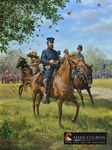Falling Waters
Battlefield Association
Battle of Falling Waters, July 2, 1861

The Battle of Falling Waters, fought on July 2, 1861, has several names and is frequently confused with an 1863 engagement. However this Civil War battle, the first in the Shenandoah Valley, also called the Battle of Hoke's Run, and the Battle of Hainesville, contributed to the Confederate victory at the Battle of Manassas (Bull Run) less than three weeks later.
Union General Robert Patterson commanded about 3,500 men, comprised of some regular troops, but mostly 90-day volunteers, whose enlistment's were about to end. He was under orders to at least pin down a small Confederate division commanded by General Joseph E. Johnston, keeping them from re-enforcing the Southern troops gathering near the town of Manassas outside of Washington, DC.
Colonel Thomas J. Jackson, who commanded a brigade under Johnston, was stationed north of Martinsburg. Upon learning from from his Cavalry screen on the morning of July 2 that Federal troops had crossed the Potomac and were marching south, Jackson ordered the 5th Virginia Regiment, approximately 380 men, and one cannon, north along the Valley Turnpike to meet them.
The two armies met just north of what is now the intersection of Hammond's Mill Road and Route 11 on the farm of William Rush Porterfield. For about 45 minutes the Virginians fought a delaying action as the Union troops brought up four cannon, and tried to surround the Confederates with their infantry. Substantially outnumbered and outgunned, the Confederates slowly retreated about a mile south, and gradually broke off fighting. There were only a few casualties on either side, although the Confederate Cavalry under Colonel J.E.B. Stuart was able to surprise and capture 49 Union soldiers.
The intensity of the Confederate fighting withdrawal caused the union forces to over estimate the Confederate strength by almost ten fold. So although tactically the Battle of Falling Waters was a Union victory, strategically the Confederates were successful. From this point on, Union General Patterson, would be less aggressive, thinking he was up against a larger Confederate force. This allowed General Johnston, along with Jackson's Virginians, to slip away and re-enforce the Confederate troops preparing to fight along Bull Run.
Less than three weeks after Falling Waters, on July 21, 1861, the Confederates won an decisive victory at the Battle of Manassas where Jackson received his sobriquet "Stonewall". The Civil Was then continued on for almost four bloody years. Falling Waters was a small battle with important repercussions. (More.....)
Local
- Home
- Mission
- Battle
- Battlefield Map
- Press Releases
- Join the FWBA
- About the FWBA
- Calm Under Fire
- Favorite Links
- Contacts
Directions
From I-81 take Spring Mills Exit 20, then proceed West on Hammonds Mill Road (WV 901). T.J. Jackson Drive is the first road on the left (south side) approximately 300 yards west of I-81. The library is on the corner, next to, but set back from the CNB Bank, across the street from the Shell Gas Station & Convenience Store. Library Phone Number: (304) 274-3443.
Next Meeting:
Thursday, November 9, 2017 - 6:30 PM at the North Berkeley Public Library 1255 TJ Jackson Drive Spring Mills, WV
Subject of Presentation:
A relatively unknown Civil War photograph possibly showing Confederate General “Stonewall” Jackson in the field will be discussed. The fascinating history of the photo itself will be reviewed, in addition to the pros and cons for identifying the figure as the famous general.
The presentation will be followed by a brief business meeting.
Follow Us On